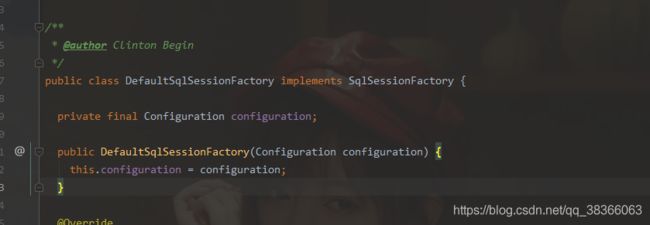mybatis源码(一)配置文件解析,mapper解析SqlSessionFactory生成
文章目录
-
- 官方网站
- 简单使用mybatis
- 简单分析
- 新建SqlSessionFactory
-
- 先看XMLConfigBuilder解析配置文件生成Configuration
- 主要讲一下mapper扫描
- XMLMapperBuilder.parse()
-
- configurationElement
- bindMapperForNamespace
- parsePendingResultMaps,parsePendingCacheRefs,parsePendingStatements
- 生成SqlSessionFactory
官方网站
mybatis3官网
mybatis配置文件
简单使用mybatis
先写个简单的测试:当然环境的话都是比较简单的,新建个表,就这三个字段进行测试,mapper跟xml可以使用插件生成,比较简单,就不多说了;

新建简单配置文件mybatis2.xml:配置文件具体信息官网都写的很详细,具体使用可以直接看官网的;
<?xml version="1.0" encoding="UTF-8"?>
<!DOCTYPE configuration
PUBLIC "-//mybatis.org//DTD Config 3.0//EN"
"http://mybatis.org/dtd/mybatis-3-config.dtd">
<configuration>
<properties>
<property name="driver" value="com.mysql.jdbc.Driver"/>
<property name="url" value="jdbc:mysql://127.0.0.1:3306/test"/>
<property name="username" value="root"/>
<property name="password" value="root"/>
<property name="org.apache.ibatis.parsing.PropertyParser.enable-default-value" value="true"/>
</properties>
<!--这是非常重要的设置 会改变mybatis的行为-->
<settings>
<!--全局地开启或关闭配置文件中的所有映射器已经配置的任何缓存。 默认为true-->
<setting name="cacheEnabled" value="true"></setting>
</settings>
<!--entity 别名 在使用type或者resultType可以直接用这个-->
<typeAliases>
<package name="com.study.springbootplus.domain.entity" ></package>
</typeAliases>
<!--类型处理器 注意如果查询用这个 则必须使用resultMap-->
<typeHandlers>
<!--<typeHandler handler=""></typeHandler>-->
</typeHandlers>
<!--即mybatis-->
<!-- <objectFactory type="com.code.analysis.mybatis.config.MyObjectFactory">
<property name="dilg" value="100"/>
</objectFactory>-->
<!--插件配置-->
<!-- <plugins>
<plugin interceptor="com.code.analysis.mybatis.plugin.ExecutorPlugin"></plugin>
</plugins>-->
<!--环境选择 可以配置多个环境 用的也不多,可以通过springboot来通过指定环境加载指定配置文件就好了-->
<environments default="development">
<environment id="development">
<transactionManager type="JDBC"/>
<dataSource type="POOLED">
<property name="driver" value="com.mysql.jdbc.Driver"/>
<property name="url" value="jdbc:mysql://127.0.0.1:3306/test"/>
<property name="username" value="root"/>
<property name="password" value="root"/>
</dataSource>
</environment>
<environment id="prod">
<!--如果使用了spring集成 那么spring会覆盖掉这儿的事物-->
<transactionManager type="JDBC"/>
<dataSource type="POOLED">
<property name="driver" value="${driver}"/>
<property name="url" value="${url}"/>
<property name="username" value="${username}"/>
<property name="password" value="${password:123456}"/>
</dataSource>
</environment>
</environments>
<!--sql.xml文件扫描-->
<mappers>
<mapper resource="mapper/UserMapper.xml"/>
</mappers>
</configuration>
写个简单的main方法进行测试:
public static void main(String[] args) throws IOException {
InputStream resourceAsStream = Resources.getResourceAsStream("mybatis2.xml");
SqlSessionFactory sqlsessionFactory = new SqlSessionFactoryBuilder().build(resourceAsStream, "development");
SqlSession session = sqlsessionFactory.openSession();
UserMapper mapper = session.getMapper(UserMapper.class);
User user = mapper.selectByPrimaryKey(1);
System.out.println(JSON.toJSONString(user));
session.close();
}
简单分析
通过读取指定的mybatis配置文件,生成SqlSessionFactory,然后通过SqlSessionFactory可以获取SqlSession,SqlSession有个方法getMapper,可以获取到对应的mapper接口,然后就可以执行mapper内部方法了;
SqlSession获取mapper比较复杂,下期将,我们这篇主要讲通过配置文件生成对应的SqlSessionFactory;
新建SqlSessionFactory
首先看SqlSessionFactoryBuilder的两个方,builder类就是用来创建对象的,源码的名字都取得超级规范,很多时候我们通过取得名字就知道这个类的作用:
public SqlSessionFactory build(InputStream inputStream, String environment, Properties properties) {
try {
//创建XMLConfigBuilder,通过XMLConfigBuilder的parse方法生成Configuration类
XMLConfigBuilder parser = new XMLConfigBuilder(inputStream, environment, properties);
//build方法就是新建一个默认的SqlSessionFactory,
// DefaultSqlSessionFactory内部维护了Configuration,具体的执行方法都是通过Configuration对象去做的
return build(parser.parse());
} catch (Exception e) {
throw ExceptionFactory.wrapException("Error building SqlSession.", e);
} finally {
ErrorContext.instance().reset();
try {
inputStream.close();
} catch (IOException e) {
// Intentionally ignore. Prefer previous error.
}
}
}
public SqlSessionFactory build(Configuration config) {
return new DefaultSqlSessionFactory(config);
}
先看XMLConfigBuilder解析配置文件生成Configuration
首先看XMLConfigBuilder的初始化,新建了个Configuration,其他解析xml生成xpath解析器,就不说了,

public Configuration parse() {
//防止重复加载
if (parsed) {
throw new BuilderException("Each XMLConfigBuilder can only be used once.");
}
parsed = true;
//解析节点的主要方法,前面将配置文件解析为XPathParser解析器就不看了,应该就是将xml解析为dom树;
parseConfiguration(parser.evalNode("/configuration"));
return configuration;
}
//主要方法,针对xml的配置文件里面的东西分方法进行解析;
//更多详细看官网配置详解,一定要看
private void parseConfiguration(XNode root) {
try {
//issue #117 read properties first
//拿到properties节点,设置configuration的Properties variables属性;
propertiesElement(root.evalNode("properties"));
//拿到settings节点,生成Properties settings对象;
Properties settings = settingsAsProperties(root.evalNode("settings"));
//根据对应的setting配置设置configuration的vfs
loadCustomVfs(settings);
//日志配置
loadCustomLogImpl(settings);
//别名配置
typeAliasesElement(root.evalNode("typeAliases"));
//插件设置,一般用来做拦截
pluginElement(root.evalNode("plugins"));
//configuration的对象工厂设置
objectFactoryElement(root.evalNode("objectFactory"));
//设置configuration的对象包装工厂
objectWrapperFactoryElement(root.evalNode("objectWrapperFactory"));
//反射工厂
reflectorFactoryElement(root.evalNode("reflectorFactory"));
//将其他settings设置;
settingsElement(settings);
// read it after objectFactory and objectWrapperFactory issue #631
//环境
environmentsElement(root.evalNode("environments"));
//设置configuration的数据库id
databaseIdProviderElement(root.evalNode("databaseIdProvider"));
//设置configuration的类型处理器
typeHandlerElement(root.evalNode("typeHandlers"));
//设置configuration的mapper扫描规则并添加mapper
mapperElement(root.evalNode("mappers"));
} catch (Exception e) {
throw new BuilderException("Error parsing SQL Mapper Configuration. Cause: " + e, e);
}
}
主要讲一下mapper扫描
//mappper配置解析
private void mapperElement(XNode parent) throws Exception {
if (parent != null) {
//单独的mapper节点
for (XNode child : parent.getChildren()) {
//package标签 , 映射文件跟mapper接口必须在同一个包,且名字对应
if ("package".equals(child.getName())) {
String mapperPackage = child.getStringAttribute("name");
configuration.addMappers(mapperPackage);
} else {
//resource标签,可以配置,url,resource,class
String resource = child.getStringAttribute("resource");
String url = child.getStringAttribute("url");
String mapperClass = child.getStringAttribute("class");
if (resource != null && url == null && mapperClass == null) {
//resource类型
ErrorContext.instance().resource(resource);
//获取mapper流
InputStream inputStream = Resources.getResourceAsStream(resource);
//初始化mapper解析器,并解析
XMLMapperBuilder mapperParser = new XMLMapperBuilder(inputStream, configuration, resource, configuration.getSqlFragments());
mapperParser.parse();
} else if (resource == null && url != null && mapperClass == null) {
//url类型
ErrorContext.instance().resource(url);
// 获取mapper流
// 初始化mapper解析器,并解析
InputStream inputStream = Resources.getUrlAsStream(url);
XMLMapperBuilder mapperParser = new XMLMapperBuilder(inputStream, configuration, url, configuration.getSqlFragments());
mapperParser.parse();
} else if (resource == null && url == null && mapperClass != null) {
// class类型
Class<?> mapperInterface = Resources.classForName(mapperClass);
//通过configuration自己的addMapper去添加
configuration.addMapper(mapperInterface);
} else {
//只能有一种节点
throw new BuilderException("A mapper element may only specify a url, resource or class, but not more than one.");
}
}
}
}
}
XMLMapperBuilder.parse()
通过class类型的跟通过xml解析的差不多,我们看一下通过xml进行加载的例子,也就是XMLMapperBuilder类的解,我们看parse方法:
public void parse() {
// 判断是否加载过
if (!configuration.isResourceLoaded(resource)) {
//拿到mapper下节点进行加载
configurationElement(parser.evalNode("/mapper"));
//加入到resource中
configuration.addLoadedResource(resource);
//将mapper跟namespace绑定
bindMapperForNamespace();
}
//进行resultmap的加载
parsePendingResultMaps();
//缓存加载
parsePendingCacheRefs();
//sql语句加载
parsePendingStatements();
}
configurationElement
private void configurationElement(XNode context) {
try {
//获取namespace,就是接口地址
String namespace = context.getStringAttribute("namespace");
if (namespace == null || namespace.equals("")) {
throw new BuilderException("Mapper's namespace cannot be empty");
}
//设置namespace
builderAssistant.setCurrentNamespace(namespace);
//缓存引用
cacheRefElement(context.evalNode("cache-ref"));
//设置缓存
cacheElement(context.evalNode("cache"));
//设置参数的parameterMap
parameterMapElement(context.evalNodes("/mapper/parameterMap"));
//设置返回的resultMap
resultMapElements(context.evalNodes("/mapper/resultMap"));
//设置sql
sqlElement(context.evalNodes("/mapper/sql"));
//设置sql的执行类型,就是增删改查
buildStatementFromContext(context.evalNodes("select|insert|update|delete"));
} catch (Exception e) {
throw new BuilderException("Error parsing Mapper XML. The XML location is '" + resource + "'. Cause: " + e, e);
}
}
bindMapperForNamespace
将mapper跟namespace进行绑定
private void bindMapperForNamespace() {
//获取namespace
String namespace = builderAssistant.getCurrentNamespace();
if (namespace != null) {
Class<?> boundType = null;
try {
//反射获取接口
boundType = Resources.classForName(namespace);
} catch (ClassNotFoundException e) {
//ignore, bound type is not required
}
if (boundType != null) {
if (!configuration.hasMapper(boundType)) {
//第一次加载指定类型mapper
// Spring may not know the real resource name so we set a flag
// to prevent loading again this resource from the mapper interface
// look at MapperAnnotationBuilder#loadXmlResource
//添加namespace
configuration.addLoadedResource("namespace:" + namespace);
//将当前通过反射获取的类型通过接口类型添加,后台通过configuration可以获取指定mapper
configuration.addMapper(boundType);
}
}
}
}
addMapper走的是configuration类内部的MapperRegistry属性的方法,而MapperRegistry就是存储mapper接口的地方,后面根据sqlsession获取mapper的时候回用的MapperRegistry内部存储的mapper接口类:

addMapper里面的方法,直接点到最终实现地方:
public <T> void addMapper(Class<T> type) {
if (type.isInterface()) {
if (hasMapper(type)) {
throw new BindingException("Type " + type + " is already known to the MapperRegistry.");
}
boolean loadCompleted = false;
try {
//新建mapper代理工厂,跟类型进行对应
knownMappers.put(type, new MapperProxyFactory<>(type));
// It's important that the type is added before the parser is run
// otherwise the binding may automatically be attempted by the
// mapper parser. If the type is already known, it won't try.
//创建对应的注解代理在进行加载一遍
MapperAnnotationBuilder parser = new MapperAnnotationBuilder(config, type);
parser.parse();
loadCompleted = true;
} finally {
if (!loadCompleted) {
knownMappers.remove(type);
}
}
}
}
parsePendingResultMaps,parsePendingCacheRefs,parsePendingStatements
这三个加载几乎一样,就只看看cacheref的解析,前面将节点的信息都保存进configuration中,这三个方法都是将对应的节点信息取出来进行处理:

使用cache就是通过namespace将存储的cache对象取出来设置为MapperBuilderAssistant的cache引用吧.

生成SqlSessionFactory
前面将mybatis.xml解析,mappper的解析都讲完了这时候就生成了Configuration对象,简单的说Configuration对象就是存储了mybatis几乎所有的配置.然后就直接通过Configuration对象生成SqlSessionFactory对象了:

DefaultSqlSessionFactory就是内部维护了Configuration对象,具体的执行都需要考Configuration对象来完成:



